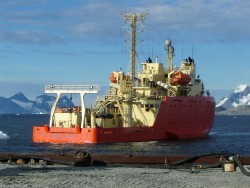Unique Barium datasets improve our understanding of oceanic carbon storage
Ice core records indicate that atmospheric carbon dioxide varies naturally over time — a process to which the Southern Ocean strongly contributes by influencing natural carbon storage capacity. First, its deep waters take up and lock away carbon and heat from the atmosphere. Then, it exerts an important control on the distribution of nutrients to a large portion of the Earth’s oceans, which in turn regulate algal population structure and thereby carbon uptake. With the BARIUM (Barium cycling in Antarctic waters: Understanding present and past ocean processes) project, Dr Kate Hendry of the University of Bristol hopes to use Ba cycling to examine how oceanic carbon storage has varied over time. ‘I worked together with my graduate students Stephanie Bates and Kimberley Pyle on making some of the most precise and accurate high-resolution measurements of seawater and marine carbonate Ba, using cutting-edge methods and instruments,’ Dr Hendry explains. ‘Our unique dataset allows us to test theories about how Southern Ocean circulation is linked to global climate over a range of timescales, and how nutrient cycling will respond to future climatic change.’ These findings could prove to be of great interest to both policy-makers and industry. The most climate-sensitive areas The team’s work was mostly focused on the WAP, which not only responds to more global temperature changes than other parts of the region, but is also strongly influenced by complex, interconnected, local and regional processes — from sea-ice and glacier dynamics to ocean and atmospheric circulation. ‘This, along with the low levels of background man-made contamination, makes the WAP a key location for understanding ocean chemistry,’ Dr Hendry points out. This didn’t prevent the team, however, from expanding their work to the Drake Passage and samples from even further afield. ‘We have produced a fantastic dataset of dissolved Ba from the WAP and Drake Passage regions of the Southern Ocean,’ she explains. ‘From the WAP shelf, our results reveal insight into the processes that control sources and sinks of Ba in seawater (sediment dissolution, sea-ice processes, ocean circulation and biology, etc.), as well as showing that there is significant variability between years as a result of changes in these processes. Our open ocean results show how the physical structure of the fronts within the Southern Ocean influences the behaviour of Ba in seawater. These results help us understand the link between Ba, nutrients and carbon drawdown in the Southern Ocean.’ In addition to this, the team produced climate records extending back through time by using sedimentary records of Ba content trapped within carbonate shells of single-celled organisms — called foraminifera — from the Southern Ocean. ‘These archives provide us with information on changes in inputs of Ba and other aspects of ocean chemistry in the past. We have found significant differences between the Ba concentration of the Southern Ocean today and 125 000 years ago, during the last warm period (interglacial) before the last ice age,’ Dr Hendry says. Ice core records show that this period was warmer than the preindustrial era and had a higher atmospheric carbon dioxide concentration, which makes it a potential point of comparison with the global warming expected over the next few decades. ‘Our results have implications for how the circulation of the Southern Ocean may respond to a warmer world, and for our predictions of future change,’ she adds. Another key result from the project lies in the first barium isotope measurements for foraminifera and for seawater in the Equatorial Atlantic, which have tremendous value for furthering scientific understanding of the processes controlling Ba distributions in seawater and helping interpret Ba archives in marine sediments. Lessons learned and plans ahead Overall, BARIUM results provide valuable information about how Ba is cycled in the ocean and how it relates to biology — who is growing in the ocean and where — as well as nutrient and carbon uptake. ‘This means that we can better understand how to use Ba archives locked away in marine sediments to interpret past changes in the ocean during periods of climatic change. In understanding how the ocean responds — or indeed drives — climate change in the past, we are in a better position to predict what will happen in the future,’ Dr Hendry says. For Dr Hendry and her team, the future promises more research and discoveries. ‘As with most scientific research, our results have opened up more questions,’ she explains. ‘One such question is the role of sea-ice in Ba cycling, and how this links to carbon uptake. We have already been able to extend our project to the Arctic, via a new collaboration with colleagues at the Norwegian Polar Institute that has included a field campaign in 2015 to investigate winter sea-ice north of Svalbard. We already have some fascinating results from this new project, so watch this space!’
Keywords
BARIUM, barium isotope measurements, climate change, West Antarctic Peninsula, ocean chemistry, ice core







